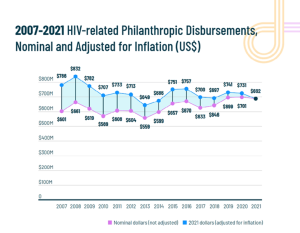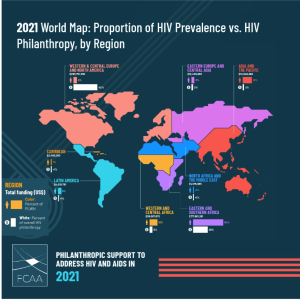Today is World AIDS Day, which is often seen as an opportunity to celebrate the progress made against HIV and AIDS. This year, we must also take stock of where the greatest challenges lie, not only for the epidemic itself, but also for the many issues—human rights, gender rights, LGBTQI rights, reproductive justice, racial justice—with which it intersects. There are warning signs that our progress is in jeopardy. In many ways, we may be going backward.
Nearly 40 million people still live with HIV globally, more than half of whom are women and girls. Young people, ages 15-24, make up more than a quarter of new HIV infections, in large part due to a lack of access to HIV and sexual and reproductive health services. The situation is most acute in sub-Saharan Africa, which is home to two-thirds of people living with HIV in the world. Key populations—including transgender people, gay men and other men who have sex with men (MSM), sex workers and their sexual partners, and people who use drugs—are disproportionately impacted. These demographics account for 70 percent of HIV infections globally and 94 percent of HIV infections outside of sub-Saharan Africa.
But no country or community is immune to the spread of HIV. As if we needed a reminder, COVID-19 made clear that an epidemic anywhere is an epidemic everywhere.
Despite this enormous challenge, HIV funding—both governmental and non-governmental grantmaking—is alarmingly off track.
Data from UNAIDS and the Kaiser Family Foundation show that, in order to meet 2025 HIV and AIDS targets in low- and middle-income countries, we will need to fill an estimated gap of $6 billion. At the same time, governments have reduced their allocations to institutions like UNAIDS and the Global Fund.
Political challenges compound the funding issues.
Populations that are most impacted by the HIV epidemic—LGBTQI communities in particular—are under attack. New laws, such as Uganda’s Anti-Homosexuality Act, are threatening the rights of LGBTQI individuals and putting the HIV response at risk. Providers are already reporting a marked decline in the utilization of HIV prevention and treatment services due to fear of arrests. Other countries, including Ghana and Kenya, are now considering their own anti-LGBTQI legislation. Trans people are also at particular risk in these environments, due to a well-resourced anti-gender movement promoting attitudes and policies that further marginalize and criminalize transgender people.
In the United States, the reauthorization of the President’s Emergency Plan for AIDS Relief (PEPFAR), the largest single donor to the global HIV response, has become increasingly politicized, with some lawmakers claiming that it is used to fund abortions. This, of course, is completely untrue. Legislation has always prohibited the use of PEPFAR resources for abortion services and related research and lobbying.
What role does philanthropy play?
Funders Concerned About AIDS (FCAA), maps the landscape of philanthropic funding for HIV and AIDS globally. Over the past four decades, the philanthropic community has provided trailblazing and often foundational support for all aspects of the fight against the disease. It has facilitated pioneering research, grassroots HIV prevention and treatment services, sexual and reproductive healthcare, and syringe exchange programs all over the world. Private sector philanthropy has augmented government resources when the latter could not or would not step up.
But this support is also at risk.
Recently, FCAA issued the 20th edition of its annual Philanthropic Support to Address HIV and AIDS report. This year’s publication found that total global philanthropic funding to fight HIV and AIDS decreased 1 percent ($9 million) between 2020 and 2021, falling to $692 million. Despite what may appear to be a minor one-year decrease, waning support for HIV is not an anomaly. When adjusted for inflation, private philanthropic resources for HIV have shown a slow decline in recent years.
There were bright spots in the report. We were pleased, for example, to see that funding for women and girls reached an historic high of $100 million. Additionally, funding for key populations reached an all-time high of $110 million, about 16 percent of all HIV-related philanthropy, in 2021.
The report also tracked the disbursement of funding by global region alongside the number of people living with HIV (PLWH). It found that a disproportionate amount of funding reached West and Central Europe and North America (predominately the U.S.), while East and Southern Africa received only 26 percent of funding, despite being home to more than half of the world’s PLWH. Notably, two of the only regions where HIV infections continue to increase— (1) Eastern Europe and Central Asia and (2) North Africa, and the Middle East—only received 2 percent of all HIV funding and less than 1 percent of all HIV funding, respectively.
Those fighting for funding and rights are being silenced.
Civil society has always been central to advocacy, resource mobilization, and protecting the rights of those most impacted by HIV. In recent years, it has been under increasing pressure as governments across the world place restrictions on organizations’ registration, funding, and operations. Their right to information, speech, and protest are being curtailed if not entirely eliminated.
This effort to silence civil society also may be harming people’s health. Recent data from the Global Fund indicate that countries that repress civil society could be enabling diseases to flourish. In its Advocacy Roadmap, the Global Fund found that, in 2021, 78 percent of deaths from HIV, tuberculosis, and malaria—and 83 percent of new infections—occurred in countries where civil society was classified as closed or repressed.
To reach our goals, we must build bridges and eliminate siloes.
Though philanthropy is capable of great progress in the global HIV and AIDS response, we must adapt our approach in order to meet the moment. The stubborn trend of flatlining—or, in reality, diminishing—funding cannot stand. Infringements on human rights cannot stand.
These challenges are intersectional. We no longer have the luxury of thinking about one sector, community, or constituency at a time. Supporting the people and places most impacted by HIV will not only end the epidemic, it will increase access to healthcare, racial and gender justice, sexual and reproductive health and rights, and democracy in the long run.
Our opposition, the anti-rights and anti-gender movements, know this well and are quite adept at connecting their work across rights, health, and access. To defeat them, we must do the same.
This World AIDS Day, it’s more important than ever to raise our collective voice, lift up those who most need to be heard, advocate for continued progress, and eradicate the obstacles that continue to stand in our way.
Masen Davis is Executive Director of Funders Concerned About AIDS. He is a seasoned social justice leader and nonprofit executive who has spent more than twenty years advancing human rights and healthcare for vulnerable populations.






Comments (0)
One of my mantras is "It's all connected." HIV/AIDS has always been a dramatic example of that. Thank you for reminding everyone that HIV/AIDS funding is also connected to a broad range of human rights issues.